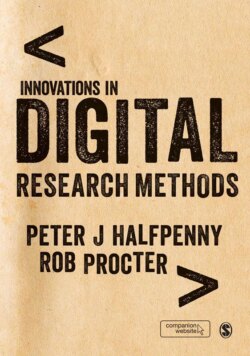Читать книгу Innovations in Digital Research Methods - Группа авторов - Страница 40
На сайте Литреса книга снята с продажи.
2.2 The Social Science Data Present 2.2.1 The Data Landscape
ОглавлениеIt has been clear since the 1980s that the half century either side of the millennium would be characterized by an information revolution (Purdam et al., 2004; Sweeney, 2001). One key aspect of this is the massive increase not just in the amount of data but also in the types of data sources available and in the range of organizations and individuals collecting, storing and using data. For example, it is estimated that in 2014 there are 1.3 billion active Facebook accounts, 0.6 billion active Twitter accounts and 58 million tweets per day (Datablog, 2014).
The growth in different data types, formats and coverage allow new approaches to social science research and evidence-based policy processes. It is perhaps useful to consider an example: the UK government has launched an initiative to measure the nation’s happiness and well-being using questions in the Integrated Household Survey.7 This intentional data gathering sample survey includes questions such as:
How satisfied are you with your life nowadays? How happy did you feel yesterday? How anxious did you feel yesterday? To what extent do you feel the things you do in your life are worthwhile?
The data is collected by professional fieldworkers and the survey takes over a year to complete. The sampling strategy enables inferences to be made to the UK population. At the same time, a university-based project in the UK is measuring happiness by texting a purposive, non-representative sample of volunteers who have signed up to be part of a mobile phone-based study.8 The participants are asked every few days how they feel on a scale and about who they are with, their location and what they are doing. They are also able to submit a photo should they wish to. From this almost real time and repeated response data, happiness maps can be produced. Other research techniques to measure happiness might be to analyse data from Twitter posts for a sense of happiness or to analyse search engine records for evidence of future planning which can be calibrated as proxies for happiness (again, though, based on non-representative samples). See, for example, Preis et al. (2012) who used Google Trends data in a cross-national study of orientation towards the future and optimism. The self-published, consequential and trace data forms are very different from data gathered as part of random sample surveys. However, all these data and methods for measuring happiness have different explanatory power and value.
The opportunity for social science and policy makers is that citizens are – deliberately or consequentially – creating their own digital archives. This means that data generation with self-published, consequential and trace data is not a distinct (or costly) stage in the research process but is integral to the activity being undertaken. As we discuss below, such data can be collated, visualized and analysed in near real time, and updated continually. Citizens have the tools to document their own lives almost effortlessly and in more detail than ever before through access to monitoring technology and potential access to data about their health, movements and communications. See, for example, the development of so-called life logging and the Quantified Self.9 Data generation can also take the form of crowdsourced data, where collective intelligence and effort in the form of observations, data preparation tasks, idea generation and individual-level data are deposited and uploaded by volunteers, usually via the internet.10 Such data can also be collated automatically using software that captures information, including text and images on websites, to build databases. This can include collecting contact information, such as email and postal addresses, to produce samples for more traditional research methods such as surveys.11
As social science researchers looking at the wealth of new types of data, we must be mindful of the famous aphorism: ‘the medium is the message’ (McLuhan, 1964). All data collection instruments, as we consider below, are subjective and performative media (although to differing extents). With the new data sources (and social media sources in particular), this issue is likely to be all the more salient. Social science researchers must be aware that the media and data are mutually embedded in a manner that affects the data we might use. The flip side of this challenge is that the gap between data and subject, between my-self and my-data or data collected about me, is closing both temporally (data about us is more closely contemporaneous to the activity/behaviour that has generated the data) and ontologically (more and more the data and the activity are one and the same thing).
So where does this take the social scientist? Is it just more choices about the data to collect, use and link? Or is it more fundamentally a step change in how people’s lives are being captured, documented and measured? What challenges are posed, for example, in terms of data access and data quality?
